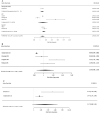Impact of pharmacy intervention on influenza vaccination acceptance: a systematic literature review and meta-analysis
- PMID: 34047881
- PMCID: PMC8161720
- DOI: 10.1007/s11096-021-01250-1
Impact of pharmacy intervention on influenza vaccination acceptance: a systematic literature review and meta-analysis
Abstract
Background Vaccination plays an important role in the prevention of influenza. Channels that improve vaccination adherence can play a vital part in improving patient care. This study seeks to inform the design and implementation of pharmacy interventions at scale on improving influenza vaccination rates. Aim of the review The aim of this study was to identify key success factors for effective pharmacy intervention design and implementation to improve vaccination acceptance rates in influenza. Methods A systematic search of MEDLINE, Embase, and Cochrane CENTRAL was performed to find literature on influenza vaccinations delivered at pharmacies, pharmacist-delivered influenza vaccinations, or influenza vaccination campaigns originating in the pharmacy setting. A meta-analysis using a random effects model estimated the impact of pharmacy intervention on vaccination rates (assessed as relative risk [RR] and 95% confidence intervals [95% CI]). Results A total of 1221 studies were found that met the search criteria, of which 12 were selected for the literature review following eligibility screening. A meta-analysis of studies that contained binary total population and vaccination rate data was conducted on 6 studies, including 3182 participants, the vaccination rate was 24% higher in those who used the pharmacy-based intervention compared with those who used standard care [RR (95% CI) 1.24 (1.05, 1.47)]. Two separate sensitivity analyses were run for the vaccination rate. In participants aged ≥ 65 years, the vaccination rate was 3% higher in those who received the pharmacy-based intervention compared with those who received standard care; however, this change was not significant [RR (95% CI) 1.03 (0.86, 1.24)]. Additionally, a qualitative review showed that more successful pharmacy-based interventions were those with the more active involvement of pharmacists in routine care. This included regular checkup of vaccine status, proactive conversations and recommendations about vaccination, and pharmacy-based immunization programs, with specific vaccination days. In-pharmacy communication rather than passive information, such as through leaflets and posters was also more effective. Conclusion Pharmacists can play a significant role to improve patient treatment, adherence, and outcomes associated with influenza vaccines. Once pharmacy-based immunization is established, proactive involvement of is key to ensure successful program implementation and results. Expanding access for pharmacists and pharmacy intervention to provide vaccinations may increase vaccination acceptance and could be a valuable intervention in patient care. Additional studies should consider high-risk populations to inform optimal design and implementation strategies.
Keywords: Acceptance; Influenza; Pharmacist; Vaccine.
© 2021. The Author(s).
Conflict of interest statement
None.
Figures


Similar articles
-
Interventions targeted at women to encourage the uptake of cervical screening.Cochrane Database Syst Rev. 2021 Sep 6;9(9):CD002834. doi: 10.1002/14651858.CD002834.pub3. Cochrane Database Syst Rev. 2021. PMID: 34694000 Free PMC article.
-
Interventions to increase influenza vaccination rates of those 60 years and older in the community.Cochrane Database Syst Rev. 2018 May 30;5(5):CD005188. doi: 10.1002/14651858.CD005188.pub4. Cochrane Database Syst Rev. 2018. PMID: 29845606 Free PMC article.
-
Face-to-face interventions for informing or educating parents about early childhood vaccination.Cochrane Database Syst Rev. 2018 May 8;5(5):CD010038. doi: 10.1002/14651858.CD010038.pub3. Cochrane Database Syst Rev. 2018. PMID: 29736980 Free PMC article.
-
Strategies to improve smoking cessation rates in primary care.Cochrane Database Syst Rev. 2021 Sep 6;9(9):CD011556. doi: 10.1002/14651858.CD011556.pub2. Cochrane Database Syst Rev. 2021. PMID: 34693994 Free PMC article.
-
Home treatment for mental health problems: a systematic review.Health Technol Assess. 2001;5(15):1-139. doi: 10.3310/hta5150. Health Technol Assess. 2001. PMID: 11532236
Cited by
-
Marketing Two Immunization Services at a Regional Supermarket Chain Pharmacy.Pharmacy (Basel). 2023 Jun 15;11(3):103. doi: 10.3390/pharmacy11030103. Pharmacy (Basel). 2023. PMID: 37368429 Free PMC article.
-
Patient satisfaction with pharmacist-administered COVID-19 vaccines in Poland: a survey study in the vaccination centres context.BMC Health Serv Res. 2022 Nov 11;22(1):1339. doi: 10.1186/s12913-022-08720-w. BMC Health Serv Res. 2022. PMID: 36368986 Free PMC article.
-
Pharmacy-Based Influenza Vaccination: A Study of Patient Acceptance in Romania.Risk Manag Healthc Policy. 2024 Apr 24;17:1005-1013. doi: 10.2147/RMHP.S459369. eCollection 2024. Risk Manag Healthc Policy. 2024. PMID: 38690537 Free PMC article.
-
Expanding vaccination provider types and administration sites can increase vaccination uptake: A systematic literature review of the evidence in non-United States geographies.Hum Vaccin Immunother. 2025 Dec;21(1):2463732. doi: 10.1080/21645515.2025.2463732. Epub 2025 Mar 2. Hum Vaccin Immunother. 2025. PMID: 40025682 Free PMC article.
-
A review of factors influencing vaccination policies and programs for older adults globally.Hum Vaccin Immunother. 2023 Dec 31;19(1):2157164. doi: 10.1080/21645515.2022.2157164. Epub 2023 Jan 19. Hum Vaccin Immunother. 2023. PMID: 36656057 Free PMC article. Review.
References
-
- Centers for Disease Control and Prevention: National Center for Immunization and Respiratory Diseases (NCIRD). People 65 Years and Older & Influenza. [Internet]. 2019 [cited 2019 March 20]. Available from: https://www.cdc.gov/flu/highrisk/65over.htm.
-
- Centers for Disease Control and Prevention. What are the benefits of flu vaccination? [Internet].2019 [cited 2019 March 20]. Available from: https://www.cdc.gov/flu/prevent/vaccine-benefits.htm.
Publication types
MeSH terms
Substances
LinkOut - more resources
Full Text Sources
Other Literature Sources
Medical
Miscellaneous

